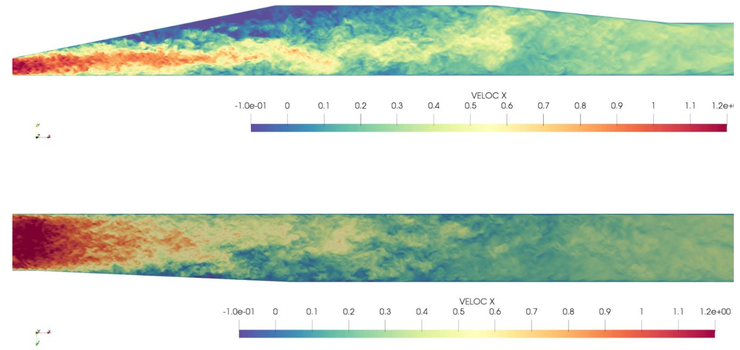DNS 1-3: Difference between revisions
| Line 7: | Line 7: | ||
__NOTOC__ | __NOTOC__ | ||
= Abstract = | = Abstract = | ||
The 3D (Stanford) Diffuser is identified as a case with complex internal corner flow and 3D separation, is well documented (see, e.g., test case | The 3D (Stanford) Diffuser is identified as a case with complex internal corner flow and 3D separation, is well documented (see, e.g., [[UFR_4-16_Test_Case]]) and has a relatively simple geometry. The diffuser has an inlet section, an expansion section and an outlet section (see Figure 1). The flow at the inlet is assumed to be a fully developed rectangular channel flow. At the outlet, standard Dirichlet condition for the pressure is prescribed. A Reynolds number of 10000 is considered. | ||
This test case concerns a highly resolved Direct Numerical Simulation (DNS) using the in-house Finite Element Method (FEM) code Alya developed at BSC. The parallel multi-physics code Alya has been designed for large-scale parallel applications and uses a non-incremental fractional-step method to stabilize pressure, with an explicit fourth-order Runge-Kutta time integration scheme. The final scheme preserves momentum, angular momentum and kinetic energy at the discrete level. | |||
The results of this project will be used to assess computational strategies | |||
(compressible vs incompressible DNS) and provide a rich database for verification and validation on subsequent computational campaigns. | |||
<div id="figure1"></div> | <div id="figure1"></div> | ||
| Line 18: | Line 25: | ||
|} | |} | ||
<!--{{Demo_UFR_Guidance}}--> | <!--{{Demo_UFR_Guidance}}--> | ||
<br/> | <br/> | ||
Revision as of 09:35, 15 November 2021
Flow in a 3D diffuser
Abstract
The 3D (Stanford) Diffuser is identified as a case with complex internal corner flow and 3D separation, is well documented (see, e.g., UFR_4-16_Test_Case) and has a relatively simple geometry. The diffuser has an inlet section, an expansion section and an outlet section (see Figure 1). The flow at the inlet is assumed to be a fully developed rectangular channel flow. At the outlet, standard Dirichlet condition for the pressure is prescribed. A Reynolds number of 10000 is considered.
This test case concerns a highly resolved Direct Numerical Simulation (DNS) using the in-house Finite Element Method (FEM) code Alya developed at BSC. The parallel multi-physics code Alya has been designed for large-scale parallel applications and uses a non-incremental fractional-step method to stabilize pressure, with an explicit fourth-order Runge-Kutta time integration scheme. The final scheme preserves momentum, angular momentum and kinetic energy at the discrete level.
The results of this project will be used to assess computational strategies
(compressible vs incompressible DNS) and provide a rich database for verification and validation on subsequent computational campaigns.

|
| Figure 1: Stanford double diffuser, Re=10000, preliminary validation. Non-dimensional instantaneous velocity at the two middle planes using Alya with 250 Million DoF and P2 polynomials. |
Contributed by: Oriol Lehmkuhl, Arnau Miro — Barcelona Supercomputing Center (BSC)
© copyright ERCOFTAC 2024